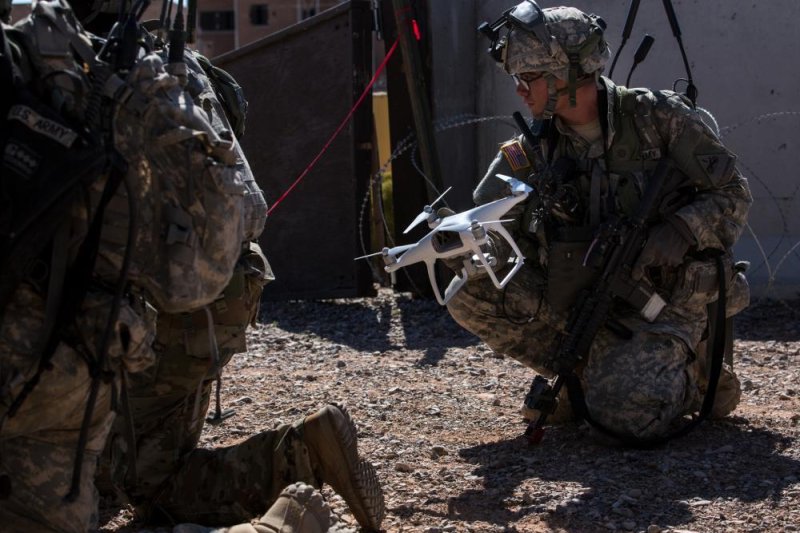Infantrymen in the U.S. Army retrieve an enemy drone during the Army Warfighter Assessment (AWA) 17-1 exercise at Ft. Bliss, N.M., on Oct. 23, 2016. A Russian defense contractor announced it has developed a new kind of weapon that can disable swarms of mini combat drones. Photo by Sgt. Steven Hitchcock/U.S. Army
A Russian defense company announced it has finished work on a new kind of weapon designed to disable swarms of mini combat drones.
The weapon, produced by Russia's United Instrument Manufacturing Corporation, will fry the drones' radio-electric systems, according to sources, turning a drone into "a useless piece of iron and plastic."
Drones, which armies began using as weapons about 10 years ago, have completely changed the situation on the battlefield, where the soldier is gradually being squeezed out as the main combat unit.
Reconnaissance and attack, things that earlier were impossible to do without direct human involvement, can now be done by robots.
From the outside, drones look like mini models of airplanes. But effective weapons can be mounted on them -- and not necessarily guns or missiles. The drone is almost an ideal platform for positioning electronic warfare devices.
The Swarm System is the latest development from the American defense industry. The idea of the system is simple: to confuse the enemy's air defense systems by creating interference.
The concept has already been used on several occasions, and not unsuccessfully. Swarm's particularity, however, is that drones are employed to block the functions of radar stations.
The system does not consist of one or two machines. Its name speaks for itself. The carrier, which can be any flying apparatus, launches several dozen drones, which act like a swarm of bees.
Each drone is an autonomous combat unit. It can be equipped with any type of weapon, from a missile to an electronic device. Swarm acts as an organic whole. Each of the drones making up the system has a certain function, such as conducting reconnaissance, creating interference or launching a missile strike.
The drones simultaneously transfer information to a single control point and exchange it with each other.
This results in a new type of combat system capable of suppressing enemy radar and also striking targets in the given location. Traditional air defense systems are helpless against Swarm. It is practically impossible to suppress it with missiles.
How the new Russian weapon will fight Swarm
If Swarm is able to reach its target, it is almost impossible to stop. That is why the new weapon created by Russian engineers is designed to block it as it is approaching.
Unlike the systems from the previous generation, instead of simply creating radio interference, the new weapon incapacitates all drones' on-board electronics. The drones are not destroyed physically: They are just turned into plain pieces of metal. Instead of ineffective fire targeting a miniature flying apparatus, a completely different tactic is used. It disrupts communication between the drones in the swarm and their central control.
For now, the development is confidential and how exactly the Russian weapon acts technically against the flock of drones is not being divulged. Specialists assume that the system works by inflicting electromagnetic damage on its target.
Russia has long relied on the combat use of electromagnetic radiation. If it is used in this new weapon, the drones are struck by a high-voltage current, which literally burns their insides. An electromagnetic bomb is also effective against them.
Exploding at a height of several hundred feet, an electromagnetic bomb incapacitates all electronics in a two-and-a-half-mile radius. Many questions, however, still remain unanswered. For example, it is not known how exactly the striking electromagnetic impulse will be generated and directed. It is clear, however, that Russian weapons are entering a new level of development.
The article originally appeared at Russia Beyond the Headlines.















